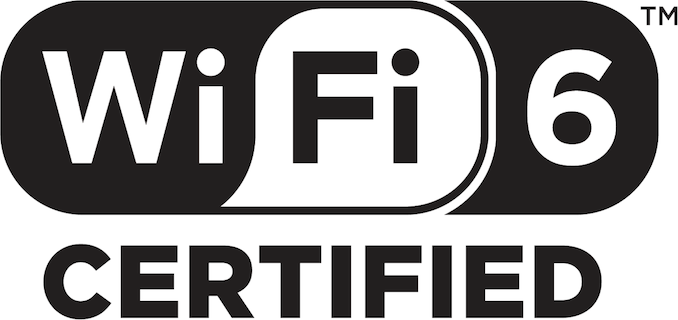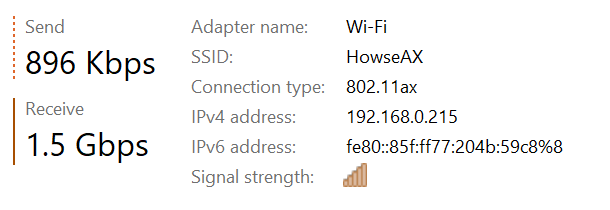AT 101: Wi-Fi 6 And Why You Want It
by Brett Howse on February 12, 2020 8:00 AM ESTTo The Future
If the question is do you need Wi-Fi 6, the answer is most assuredly “maybe”. The performance improvements are substantial, but really rely on a very strong signal to get the most data throughput. Most of the new features of Wi-Fi 6 focus on the influx of devices to the standard, and dealing with many devices connected to the same access point, or devices trying to share spectrum when connected to different access points.
The addition of Orthogonal Frequency Division Multiple Access to the Wi-Fi 6 standard will likely be the most impactful change to this revision. It will allow access points to carve up their channels into smaller slices, allowing more devices to communicate at the same time with less overhead. Each device will lose out on peak throughput, but the reduced latency should help a lot, especially in very dense environments. It should help with excessive overhead on the network layer when multiple devices are sending many small packets at once, which is a very common scenario, especially in an office or stadium situation.
Multi-User MIMO was in the Wi-Fi 5 specification as an optional implementation, and as such it did not really take off. Wi-Fi 6 should make this more prevalent, and also adds support to the MU-MIMO on the uplink, not just the downlink side. This will increase the capacity of access points for higher-speed use cases, but MU-MIMO did not get a lot of traction in Wi-Fi 5 so we will have to see how much adoption it gets in Wi-Fi 6.
The wider 160 MHz channels will offer significantly more throughput in the home environment, as we saw in our performance tests. As with the 1024-level QAM though, to see the biggest benefit you will need a strong signal. The vast majority of home networking is still limited to 1 Gigabit Ethernet, which puts Wi-Fi 6 into somewhat of an awkward spot, since it can transfer faster than most wired home networks, but even so, that is still a significant improvement over Wi-Fi 5 which would cap out around 600 Mbps on the best Wi-Fi adapters. If you work with a lot of large files, and you prefer to use Wi-Fi instead of the more consistent, yet cumbersome Ethernet, there’s still a nice boost to be had.
The future looks strong for Wi-Fi, and the Wi-Fi Alliance has made some excellent revisions to their standard to help improve Wi-Fi for the next generation of devices. As with any standards change, the impacts will not be seen right away. Both the access point, and the client need to be leveraging the new standard for the improvements to be noticeable. We’ve already seen the latest generation of smartphones start to offer Wi-Fi 6, and there’s been some movement in the PC space as well with Intel’s Project Athena. Anyone looking at a new router today should certainly opt for a Wi-Fi 6 model, but there’s likely not a major need for most people to move from Wi-Fi 5 access points right away. If you live in a heavily congested wireless area, the advantages of features like BSS coloring and Spatial Frequency Reuse should help out in those scenarios, but for people looking at purely performance, Wi-Fi 6 somewhat runs into a wall of its own making, since it can now transfer at over Gigabit speeds on a typical 2x2:2 connection. But who are we to question performance?












149 Comments
View All Comments
TheUnhandledException - Friday, February 14, 2020 - link
Wired (copper) is already capable of 10 Gbps and 40 Gbps speed. Fiber even more than that. Let me know when wifi can do 40 Gbps or even 10 Gbps. Not in a lab but real world with congestion from neighbors wasting bandwidth running their inefficient 802.11b/g devices.GreenReaper - Friday, February 14, 2020 - link
Hint: If it's in the air, it's not a fibre. Such fibres are also known as cables. "Air fiber" doesn't exist.If you're the *only* person using a wireless connection, you may achieve a reasonable fraction of its maximum performance - in one direction. But it doesn't come close to what you can get wired. The real question is whether you are willing to pay for that performance. Most consumers don't need to, and therefore consume kit doesn't have it. When there is a need for it, it'll be available, because as others mentioned the capability is there - and it has been for over a decade.
Makaveli - Friday, February 14, 2020 - link
lol there is always someone like this.Keep on dreaming.
syleishere - Thursday, February 13, 2020 - link
Also remember phone lines and cable lines are on their way out. I'd be looking into Elon Musk satellite project starlink and the cell phone companies 5G networks for fastest internet over next few years. Remember air is faster, more spectrums can be used than you can get on a wired connection. I'd keep them around anyways, I prefer gaming on wired especially when raiding in ff14, but wireless one day will be the way to download those 50gb files for your 8k TV on torrents faster so keep that in mind. Air is faster, wired from phone lines and cable lines will be slower.Whiteknight2020 - Thursday, February 13, 2020 - link
"air is faster"Except when there's
Cloud
Rain
Snow
Pollution
EM interference
Congestion
Solar flares
Unlike a completely unobstructed piece of glass or copper. Which, oddly,is why we hook up all our critical stuff with.... Copper & glass.
Korguz - Friday, February 14, 2020 - link
syleishere...yea ok sure.. could you share what ever it is you are on.. so the rest of us can believe the same nonsense you do ?
GreenReaper - Friday, February 14, 2020 - link
Both mediums have their place. Wireless's place is in the kitchen - not gaming or the datacenter.Hyper72 - Saturday, February 15, 2020 - link
Indeed, it's all about use case and environment. I got an Asus RT-AX88U last year and have been gaming a lot over WiFi. It's rock solid, never a single disconnect and latency to the router is sub 1ms - all significant latency for gaming is further out in the network. I couldn't say the same about my old Netgear R7000.I also get ~100MB/s from my NAS which is great for the work I do at home.
peevee - Thursday, February 13, 2020 - link
If only a few major countries would open up more channels close to 2.4 (below 2.4 or above 2.5), we could have had the best of both worlds - performance and range. Who is hoarding 2.5-3GHz range for example?TheUnhandledException - Friday, February 14, 2020 - link
Below 2.4 GHz is a number of military bands. In the US above 2.5 GHz (well above 2.495 GHz) is the cellular band allocated to Sprint (now T-Mobile after the merger). I don't see the 2.4 GHz ISM band (which is what wifi uses) getting expanded.